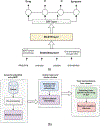A framework for multi-faceted content analysis of social media chatter regarding non-medical use of prescription medications
- PMID: 37680768
- PMCID: PMC10483682
- DOI: 10.1186/s44247-023-00029-w
A framework for multi-faceted content analysis of social media chatter regarding non-medical use of prescription medications
Abstract
Background: Substance use, including the non-medical use of prescription medications, is a global health problem resulting in hundreds of thousands of overdose deaths and other health problems. Social media has emerged as a potent source of information for studying substance use-related behaviours and their consequences. Mining large-scale social media data on the topic requires the development of natural language processing (NLP) and machine learning frameworks customized for this problem. Our objective in this research is to develop a framework for conducting a content analysis of Twitter chatter about the non-medical use of a set of prescription medications.
Methods: We collected Twitter data for four medications-fentanyl and morphine (opioids), alprazolam (benzodiazepine), and Adderall® (stimulant), and identified posts that indicated non-medical use using an automatic machine learning classifier. In our NLP framework, we applied supervised named entity recognition (NER) to identify other substances mentioned, symptoms, and adverse events. We applied unsupervised topic modelling to identify latent topics associated with the chatter for each medication.
Results: The quantitative analysis demonstrated the performance of the proposed NER approach in identifying substance-related entities from data with a high degree of accuracy compared to the baseline methods. The performance evaluation of the topic modelling was also notable. The qualitative analysis revealed knowledge about the use, non-medical use, and side effects of these medications in individuals and communities.
Conclusions: NLP-based analyses of Twitter chatter associated with prescription medications belonging to different categories provide multi-faceted insights about their use and consequences. Our developed framework can be applied to chatter about other substances. Further research can validate the predictive value of this information on the prevention, assessment, and management of these disorders.
Keywords: Machine learning; Natural language processing; Social media; Substance use.
Conflict of interest statement
Competing interests The authors declare no competing interests.
Figures






Similar articles
-
Machine Learning and Natural Language Processing for Geolocation-Centric Monitoring and Characterization of Opioid-Related Social Media Chatter.JAMA Netw Open. 2019 Nov 1;2(11):e1914672. doi: 10.1001/jamanetworkopen.2019.14672. JAMA Netw Open. 2019. PMID: 31693125 Free PMC article.
-
Promoting Reproducible Research for Characterizing Nonmedical Use of Medications Through Data Annotation: Description of a Twitter Corpus and Guidelines.J Med Internet Res. 2020 Feb 26;22(2):e15861. doi: 10.2196/15861. J Med Internet Res. 2020. PMID: 32130117 Free PMC article.
-
Social Media Mining for Toxicovigilance: Automatic Monitoring of Prescription Medication Abuse from Twitter.Drug Saf. 2016 Mar;39(3):231-40. doi: 10.1007/s40264-015-0379-4. Drug Saf. 2016. PMID: 26748505 Free PMC article.
-
Mining social media for prescription medication abuse monitoring: a review and proposal for a data-centric framework.J Am Med Inform Assoc. 2020 Feb 1;27(2):315-329. doi: 10.1093/jamia/ocz162. J Am Med Inform Assoc. 2020. PMID: 31584645 Free PMC article. Review.
-
Natural Language Processing and Its Implications for the Future of Medication Safety: A Narrative Review of Recent Advances and Challenges.Pharmacotherapy. 2018 Aug;38(8):822-841. doi: 10.1002/phar.2151. Epub 2018 Jul 22. Pharmacotherapy. 2018. PMID: 29884988 Review.
Cited by
-
Insights into the Experiences of Persons with Substance Use Disorders During COVID-19 Lockdown in Lagos, Nigeria: A Qualitative Investigation.Subst Use. 2024 Dec 17;18:29768357241307752. doi: 10.1177/29768357241307752. eCollection 2024 Jan-Dec. Subst Use. 2024. PMID: 39691942 Free PMC article.
-
Which social media platforms facilitate monitoring the opioid crisis?PLOS Digit Health. 2025 Apr 28;4(4):e0000842. doi: 10.1371/journal.pdig.0000842. eCollection 2025 Apr. PLOS Digit Health. 2025. PMID: 40293990 Free PMC article.
-
AI-powered topic modeling: comparing LDA and BERTopic in analyzing opioid-related cardiovascular risks in women.Exp Biol Med (Maywood). 2025 Feb 28;250:10389. doi: 10.3389/ebm.2025.10389. eCollection 2025. Exp Biol Med (Maywood). 2025. PMID: 40093658 Free PMC article.
-
Performance Improvement of a Natural Language Processing Tool for Extracting Patient Narratives Related to Medical States From Japanese Pharmaceutical Care Records by Increasing the Amount of Training Data: Natural Language Processing Analysis and Validation Study.JMIR Med Inform. 2025 Mar 4;13:e68863. doi: 10.2196/68863. JMIR Med Inform. 2025. PMID: 40053805 Free PMC article.
-
"I Been Taking Adderall Mixing it With Lean, Hope I Don't Wake Up Out My Sleep": Harnessing Twitter to Understand Nonmedical Prescription Stimulant Use among Black Women and Men Subscribers.medRxiv [Preprint]. 2024 Dec 5:2024.12.03.24318408. doi: 10.1101/2024.12.03.24318408. medRxiv. 2024. PMID: 39677440 Free PMC article. Preprint.
References
-
- Ahmad FB, Cisewski JA, Rossen LM, Sutton P. Products - Vital Statistics Rapid Release - Provisional Drug Overdose Data. National Center for Health Statistics. 2022.
-
- Hughes A, Williams MR, Lipari RN, Bose J, Copello EA, Kroutil LA. Prescription drug use and misuse in the United States: results from the 2015 national survey on drug use and health. NSDUH data review, substance abuse and mental health services administration. Natl Survey Drug Use Health. 2016;2016:1–41.
-
- Singh J Centers for disease control and prevention. Indian J Pharmacol. 2004;36:268–9. https://www.cdc.gov/. Accessed 27 Jan 2022.
-
- U.S. Food and Drug Administration. Neurontin. 2017. https://www.accessdata.fda.gov/drugsatfda_docs/label/2017/020235s064_020.... Accessed 22 July 2023.
Grants and funding
LinkOut - more resources
Full Text Sources
